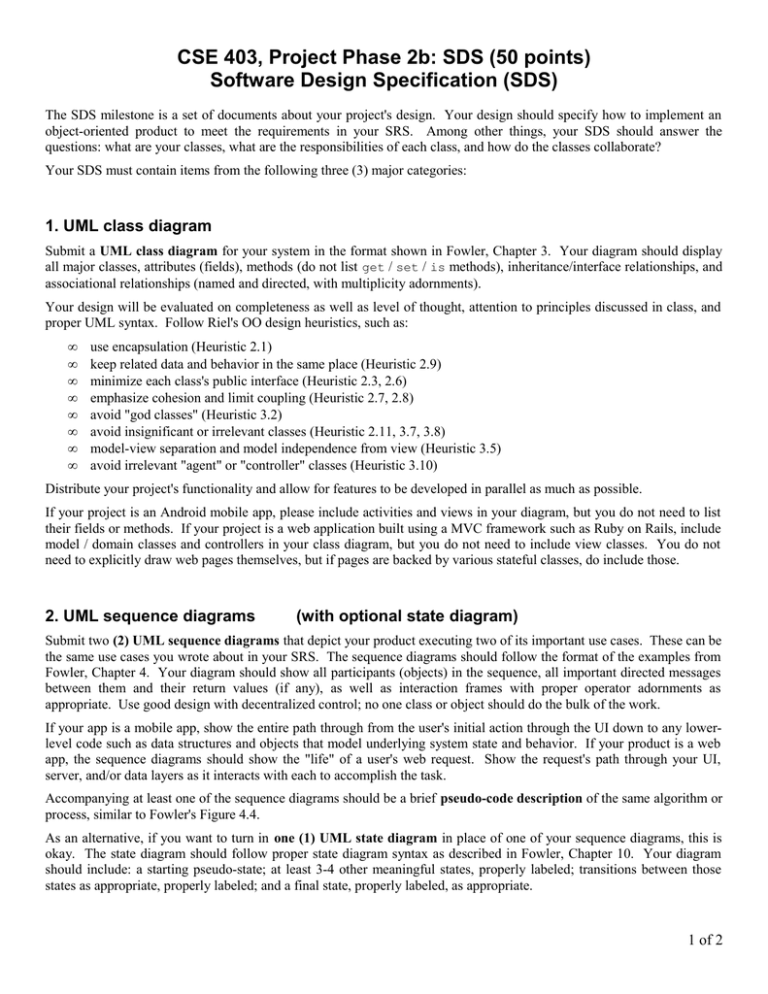
CSE 403, Project Phase 2b: SDS (50 points)
Software Design Specification (SDS)
The SDS milestone is a set of documents about your project's design. Your design should specify how to implement an
object-oriented product to meet the requirements in your SRS. Among other things, your SDS should answer the
questions: what are your classes, what are the responsibilities of each class, and how do the classes collaborate?
Your SDS must contain items from the following three (3) major categories:
1. UML class diagram
Submit a UML class diagram for your system in the format shown in Fowler, Chapter 3. Your diagram should display
all major classes, attributes (fields), methods (do not list get / set / is methods), inheritance/interface relationships, and
associational relationships (named and directed, with multiplicity adornments).
Your design will be evaluated on completeness as well as level of thought, attention to principles discussed in class, and
proper UML syntax. Follow Riel's OO design heuristics, such as:
•
•
•
•
•
•
•
•
use encapsulation (Heuristic 2.1)
keep related data and behavior in the same place (Heuristic 2.9)
minimize each class's public interface (Heuristic 2.3, 2.6)
emphasize cohesion and limit coupling (Heuristic 2.7, 2.8)
avoid "god classes" (Heuristic 3.2)
avoid insignificant or irrelevant classes (Heuristic 2.11, 3.7, 3.8)
model-view separation and model independence from view (Heuristic 3.5)
avoid irrelevant "agent" or "controller" classes (Heuristic 3.10)
Distribute your project's functionality and allow for features to be developed in parallel as much as possible.
If your project is an Android mobile app, please include activities and views in your diagram, but you do not need to list
their fields or methods. If your project is a web application built using a MVC framework such as Ruby on Rails, include
model / domain classes and controllers in your class diagram, but you do not need to include view classes. You do not
need to explicitly draw web pages themselves, but if pages are backed by various stateful classes, do include those.
2. UML sequence diagrams
(with optional state diagram)
Submit two (2) UML sequence diagrams that depict your product executing two of its important use cases. These can be
the same use cases you wrote about in your SRS. The sequence diagrams should follow the format of the examples from
Fowler, Chapter 4. Your diagram should show all participants (objects) in the sequence, all important directed messages
between them and their return values (if any), as well as interaction frames with proper operator adornments as
appropriate. Use good design with decentralized control; no one class or object should do the bulk of the work.
If your app is a mobile app, show the entire path through from the user's initial action through the UI down to any lowerlevel code such as data structures and objects that model underlying system state and behavior. If your product is a web
app, the sequence diagrams should show the "life" of a user's web request. Show the request's path through your UI,
server, and/or data layers as it interacts with each to accomplish the task.
Accompanying at least one of the sequence diagrams should be a brief pseudo-code description of the same algorithm or
process, similar to Fowler's Figure 4.4.
As an alternative, if you want to turn in one (1) UML state diagram in place of one of your sequence diagrams, this is
okay. The state diagram should follow proper state diagram syntax as described in Fowler, Chapter 10. Your diagram
should include: a starting pseudo-state; at least 3-4 other meaningful states, properly labeled; transitions between those
states as appropriate, properly labeled; and a final state, properly labeled, as appropriate.
1 of 2
3. Coding style guidelines
Submit a coding standards document (this can be a page on your project's wiki, if you like) explaining what style
conventions you plan to follow. A reference document or link with an example would be helpful. Also explain how you
plan to enforce a consistent coding style between group members. Describe any tools you plan to use to enforce these
conventions, and/or any methodologies your group members plan to use to enforce them.
Your group will be required to perform significant code reviews, as described in the Alpha spec. Plan to set aside time to
perform these code reviews, where one developer's work will be looked over by one or more others. In your coding
standards document, briefly describe how your code reviews will be done and how you will provide evidence of these
reviews to the grader. Will you take review notes by hand? Will you use tools built into the version control system to
annotate the reviewed code? Once the review is complete, what actions are taken to correct the issues and submit? Etc.
See the course web site's Links page for links to some useful tools for style checking that you may want to list here.
Submission and Grading:
Submit your SDS documents online by checking them into your version control system on GitHub by the due date. You
may submit documents on paper in lecture as well if you like; this means you must have those documents finished by the
start of class time on the next lecture on-or-after the due date in order to hand them in on time. If you submit the SDS by
checking in your diagrams on GitHub, please check them in using a file format that can be easily opened by the customer
TA without any special software. For example, if you create your diagrams using the Violet UML tool, it generates
documents in the .violet file format; but also export them to .PNG or .GIF images or PDF and check in the exported
version to your version control area as well, so the TA can open them.
Part of your grade will come from the plausibility, thoughtfulness, and level of detail of your work. For example, if you
are listing classes in your class diagram, take care not to forget important classes that would reasonably needed to solve
the task you are working on. Do not forget to include classes for all aspects of your system, such as user interface, data
modeling, database interaction, any "helper" classes or utility code, etc. In the past, some groups have focused too much
on user interface classes and have done a poor job capturing the details of the "model" of your system, the classes that
actually represent the important data and behavior necessary for the task.
List the contents of each class in detail, including a comprehensive set of fields, methods, and constructors. (Do not list
"getter" or "setter" methods that simply provide clients access to data of the object.) Part of your grade comes from
following proper UML syntax, including syntax for classes, interfaces, attributes, methods, access modifiers, parameters,
return values, and types. Also list any and all relationships that occur between classes. Your relationships should have
proper syntax for all elements mentioned in the reading, such as direction, multiplicity, and a label explaining the
relationship.
In UML sequence diagrams, we want to see that you have listed a reasonable set of steps and calls to achieve a concrete
goal described in your use cases from your SRS. Take care not to omit important steps or details. Make sure that the state
of the system at the end of the path through the diagram matches the expectations from the use case to which it relates.
Follow proper sequence diagram syntax for objects, interaction frame bars, messages between objects, and parameters.
Choose a flow of control that is reasonable for your type of project and the goal being achieved in the scenario. Ideally no
one class or object should do too large a share of the work to complete the scenario.
A small part of your grade comes from the looks or aesthetics of your documents. They do not need to be beautiful or
excessively formatted, but your customers need to be able to read them and extract information from them. This means
they should be clearly written, with proper spelling and grammar, clear wording, and drawn and formatted with a enough
organization to present your ideas clearly to the reader.
Remember that part of your grade comes from having a meaningful in-person interaction with your customer before the
phase is due to show your progress, ask questions, get feedback, and generally make sure you are on the right track.
This document and its contents are copyright © University of Washington. All rights reserved.
2 of 2

